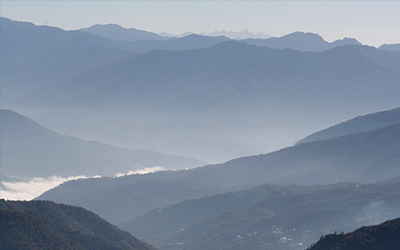Duration: 2 Night and 3 Days
This trek route gives an opportunity to experience the old trade route in between North Thimphu and Punakha. The trail was heavily used 40 years before the coming of motor road. The trail on Punakha side is very narrow.
Day 1 Paro
- After experiencing a memorable flight along skies offering you views of the Himalayan Treasures such as Mount Everest, Kanchenjunga, Bhutan’s Jomolhari amd Jitchu Drake, your flight will gradually descend, yet again enchanting you with Paro Valley’s beauty from above. The landing is thrilling and supposed to be one of the most challenging.
At the airport, you will be received by representatives of our company who will escort you to the hotel. You will check in after a welcome tea.
- Stroll around Paro town, which was developed after the airport was built in 1983.
- Visit Ta Dzong (watch tower) which was built in 1649 by Paro Governor Tenzin Drugda to protect the fortress below. The Ta Dzong was almost destroyed in 1965 but was restored by the third king Jigme Dorji Wangchuck into the National Museum of Bhutan in 1968.
- Visit Paro Dzong which was built in 1646 by Zhabdrung Rimpoche. It was built to protect Paro Valley from frequent Tibetan invasions. Today this Dzong serves as the administrative office of Paro district and also the district’s monk body.
- Visit Kyichu Lhakhang which was founded by Tibetan king Songtshen Gyambo in 659 AD. It was built to subjugate the demon occupied lands all over the Himalayas, who prevented the spread of Buddhism. The king built 108 temples in a day to overcome the demon.
- Over night at hotel in Paro.
Day 2 Paro
- Hike to Taktshang (Tiger’s Nest) Monastery, one of the holiest monastery in the Buddhist World
- Over night hotel in Paro.
Day 3 Thimphu
- Thimphu has lots to offer and the pick for you will firstly be the Memorial Chorten, one of Bhutan’s most beautiful stupas, built in memory of the Third King, Late His Majesty Jigmi Dorji Wangchuck, known as the Father of Modern Bhutan. A short drive from there will take you to Buddha Point, where the statue of the World’s largest Future Buddha (Maitreya) will be seen.
- Visit Zorichusum (meaning 13 arts and crafts) which is popularly known as the painting school. Students in this school learn traditional arts and crafts like painting, sculpture, wood carving, weaving and embroidery.
- From there we will move to the Handicraft’s Emporium, Weaving Centre and Changangkha monastery, one built in the 12th century. There will also be visits to the Takin zoo, Sangaygang, which offers a view point of Thimphu valley and a Nunnery.
- Over night at hotel in Thimphu.
Day 4
The Trek begins
Altitude gain 400m, Altitude loss 0, Distance 6 km.
- The first trek is from Thimphu to Galapang
- You drive for fifty minutes from hotel to Kabisa village, north east of Thimphu, where the trek will begin. Trail traverses through a farm road for some time followed by a steep climb through the Blue Pine forest. After one hour vegetation changes.
Day 5
Altitude gain 556m, Altitude loss 1530m. Distance 11km.
- Galapang to Dungshing Pang.
- Climb from camp site till Sinchu La pass (3530m). The pass is marked with a small stupa with some prayer flags. Trail after the pass is very narrow and heavily used by local people in olden days. Trail drops all the way to Galapang camp, the camp site in an open pasture land where farmers from Kabisa bring their cattle.
Day 6
Altitude gain 0, Altitude loss 720m, Distance 9 km.
- Dubgshing Pang to Punakha Trail drops down to a long suspension bridge towards Chorten Ningpo Lhakhang. This is an old temple founded in the 15th century by Lama Drukpa Kinley. After the temple, temple it takes an hour to reach the main road. Our driver and car will be waiting for you with fresh refreshments.
Day 7
- Punakha Dzong (Fortress), built in 1637 by Shabdrung Ngawang Namgyal has played a prominent role in the civil and religious life of the Kingdom. From far, it resembles a giant ship, rocked on a mass of still water as it is built at the confluence of two rivers – the Pho (male) and Mo (Female) rivers. Destroyed four times by fire and an earthquake in 1897, the Dzong has been now been fully restored in its original splendour. The Fortress contains some of the most sacred and significant religious relics of the nation.
- Hike for about one hour (round trip) to Drukpa Kuenley’s monastery, built in the 15th century. A monastery where the Phallus is worshipped, it is associated with Lam Drukpa Kuenley, the “Divine Madmonk”.
- Drive to Paro
- Over night at hotel in Paro.
Day 8
Departure: Our representative will see you off at the airport.
